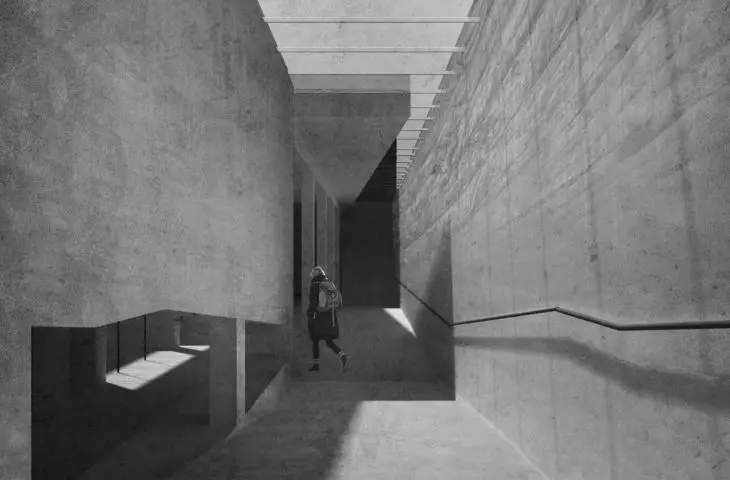{tag:studenci}, an architecture graduate from the Wroclaw University of Technology, conducted a design intervention on the site of the former Croatian Željava air base. Her proposal is a tourist shelter hidden under the aircraft taxiway and a light installation inserted into the bunker spaces. The work received an honorable mention in the SARP Wrocław 2021 Engineering Diploma of the Year competition.
Paulina Górecka's project called "Narrative Territory: shelter and light laboratory in the former Željava airbase, Croatia" is an engineering thesis under the direction of Dr. Ada Kwiatkowska.
Location of the project at the Željava airbase
© Paulina Górecka
I subjected to architectural intervention the site of the former Željava air base, located in Croatia in the immediate vicinity of the border with Bosnia and Herzegovina. The Željava underground air base was built in the late 1950s and early 1960s, at the beginning of the Cold War for the military purposes of Yugoslavia at the time, being one of the most modern and expensive military facilities. The complex of underground bunkers was excavated into the Plješevica mountain, and the entire establishment includes 3.5 kilometers of tunnels, a central base, a system of land roads and an above-ground airfield infrastructure. After the end of its operations and the withdrawal of the army, the base gradually deteriorated, but it is still of great interest to enthusiasts of this type of facility, says Paulina Górecka.
photos of the road leading to the bunker
© Paulina Górecka
design road
The basis for Paulina's design of the bunker was the runways - the first visible elements of the airport's former infrastructure, which intuitively lead to its center - the hidden underground central base.
A projection of the runway and the road leading to the bunker
© Paulina Górecka
I based the idea of the "laboratory of light" project on Vittorio Gregotti's theory, according to which the first architectural gesture does not consist in building, but in the symbolic and practical act of touching the ground. This gesture can materialize in the form of a road, which is the starting point and, as it were, an artifact of architecture. In my project I tried to create a narrative that would naturally tell the story of the site. The aforementioned experience of the road and the light played an important role here," explains the author.
The hostel is located under the taxiway of the airplane
© Paulina Górecka
light as presence
In the concept, the student referred to the anthropological concept of light, which she says can be read as the presence of humans in space. She used this theme in the concept of the hostel, where she used individual skylights placed in the rooms of the hostel to create a symbolic light code to indicate the presence of guests in the building. This solution also alludes to the runway lights of the former airport.
Using the created sequence of lights, the user is guided on the way to the bunker. The transition to the bunker becomes a process, a journey, a return to history, and the path itself becomes a narrative, Paulina adds.
roof plan of the shelter and longitudinal section
© Paulina Górecka
shelter hidden underground
Theform of the building was designed to minimize its impact on the visual perception of the surroundings. The designer decided to place the lump of the shelter under the taxiway, next to the bunker hatch No. 2, thus creating a foreground for the dominant vertical architecture of the former shelter. The road retains its function, while becoming the roof for the new building.
Visualization of the entrance area of the designed shelter
© Paulina Górecka
By hiding the block underground, I tried to give hierarchy to the history of the site and the landscape. The new building was fully inscribed into the road strip, becoming an integral part of the whole establishment. The inspiration for locating the function underground came from military infrastructure, the architecture of shelters and bunkers, I also referred to the origins of the word "shelter" - explains the author.
visualization of the shelter's night zone
© Paulina Górecka
The shelter was designed using rammed earth (rammed earth) and reinforced concrete technology. Rammed earth was used in the design at the "contact points" between the new building and the terrain, which allowed the author to achieve the effect of "gouging" the structure into the ground. As a result, visitors to the site can notice the drawing of earth layers and the characteristic texture on the retaining wall. On the other hand, when descending the ramp of the shelter, they are accompanied by the impression of descending into the depths of the earth.
plan of level -1 and longitudinal section
© Paulina Górecka
modular light installation
The author also assumed the adaptation of the existing bunker for exhibition purposes. In its space she proposed a modular installation, consisting of evenly distributed light elements. Users can control them and change the character of the interior, interact with the object. The designer planned to realize the installation in part of the bunker, which she hopes can be a leaven for its further revitalization in the future.
common area of the facility
© Paulina Górecka
My project aims to discuss the future of former military facilities, which often have high spatial and architectural value. Such objects represent potential for adaptation or opening to a wider public, Paulina Górecka concludes.


















































